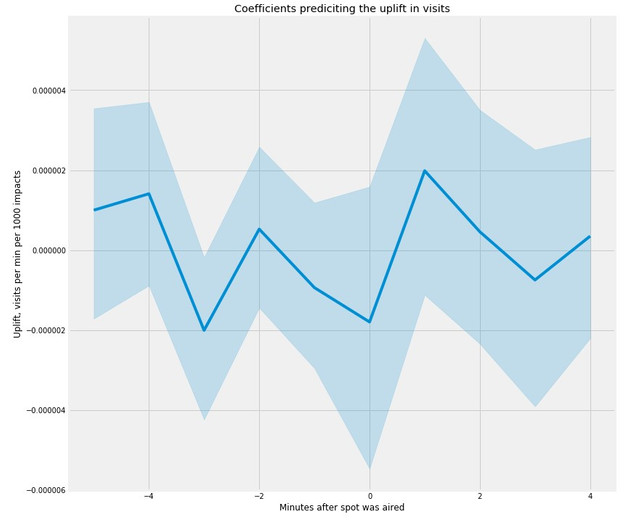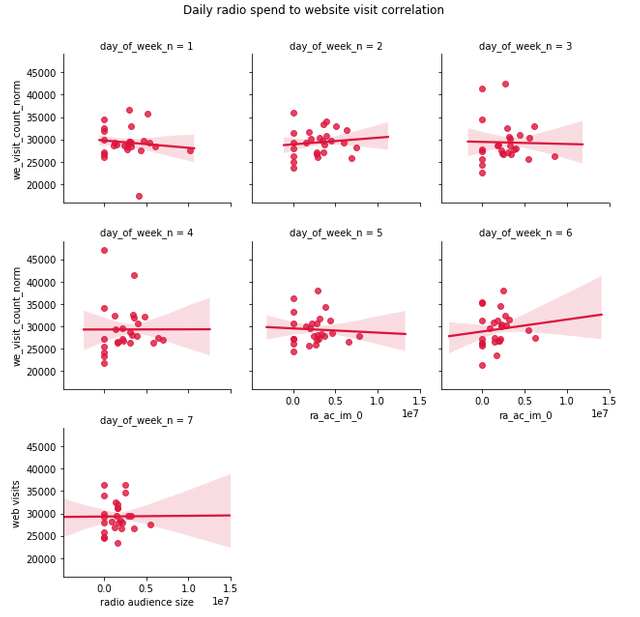Using Data to Identify Effective Marketing Channels

Recently QueryClick were asked to analyse the effect of a client’s TV and radio advertising on their website traffic. The idea was to get a clear picture of the relative effectiveness of different advertising channels.
Step 1: Cleansing the Data
We began with raw data on TV and radio advertising spots. This data arrived in a number of different formats. Our Corvidae data analysis team cleaned the data, removing spots with missing audience information and other errors. Then we converted the cleaned data from different sources into a common format to allow analysis.
Step 2: Analysis
Next we analysed the data at a number of different timescales to estimate the impact of the different advertising channels. We looked for immediate response to adverts and also for uplift in the days and weeks following advertising campaigns. What we found was quite striking.
Step 3: The Results
For this client we found a clear response to television advertising in the minutes, days and weeks after the adverts aired. In the minutes following the advert airing we found an immediate uplift in website traffic equivalent to 5 additional visits per 10000 viewers.

Additionally over the following 24 hours we found strong positive correlation between TV advertising and website visits equivalent to approximately one visitor per 700 advert viewers.

The effects were so clear that we were even able to provide our client with indications of which TV channels provided the highest proportional response allowing them to target higher performing TV channels.

Then we turned our attention to radio advertising and it was here that we found some big surprises. Analysing web traffic after radio spots, we could find absolutely no immediate uplift in website traffic. Given that individual spots had smaller audiences than many TV spots, we tried examining groups of radio spots shown at the same time, but even then we could see no effect.

Next we tried examining daily uplift data to look for correlations between radio advertising and website traffic, but once again we could not discover any correlation. In fact the overall correlation was slightly negative, but well within the margin of error of the data.

Additionally we identified one period of advertising that was geographically restricted, allowing us to compare the region where the radio adverts were broadcast to a control region where they were not. Once again this showed a very slight negative correlation across the period of time covered by the advertising.

Conclusion
The startling conclusion was that for this particular client radio advertising’s benefit was negligible compared to the benefit of TV advertising. This was a particularly valuable insight for our customer since they had been spending similar sums of money each year on the two advertising channels prior to our investigation. This new data driven insight will allow them to redirect advertising spend to maximise audience impact and drive customer engagement with their website more effectively.
Contact Us
If you would be interested in insight into the effectiveness of your different advertising channels, please contact [email protected] and we can arrange to discuss your requirements in more detail.
Own your marketing data & simplify your tech stack.
Have you read?
I have worked in SEO for 12+ years and I’ve seen the landscape shift a dozen times over. But the rollout of generative search engines (GSEs) feels like the biggest...
As you will have likely seen, last week Google released the March 2024 Core Algorithm Update. With it, comes a host of changes aiming to improve the quality of ranking...
After a year of seemingly constant Google core updates and the increasingly widespread usage of AI, the SEO landscape is changing more quickly than ever. With this rapid pace of...


